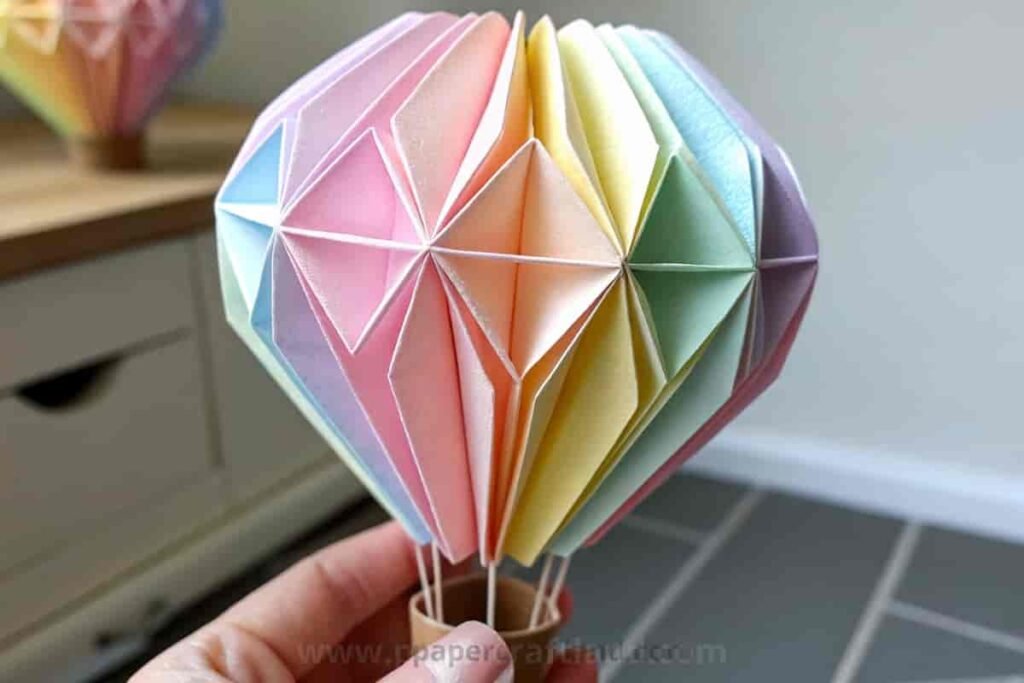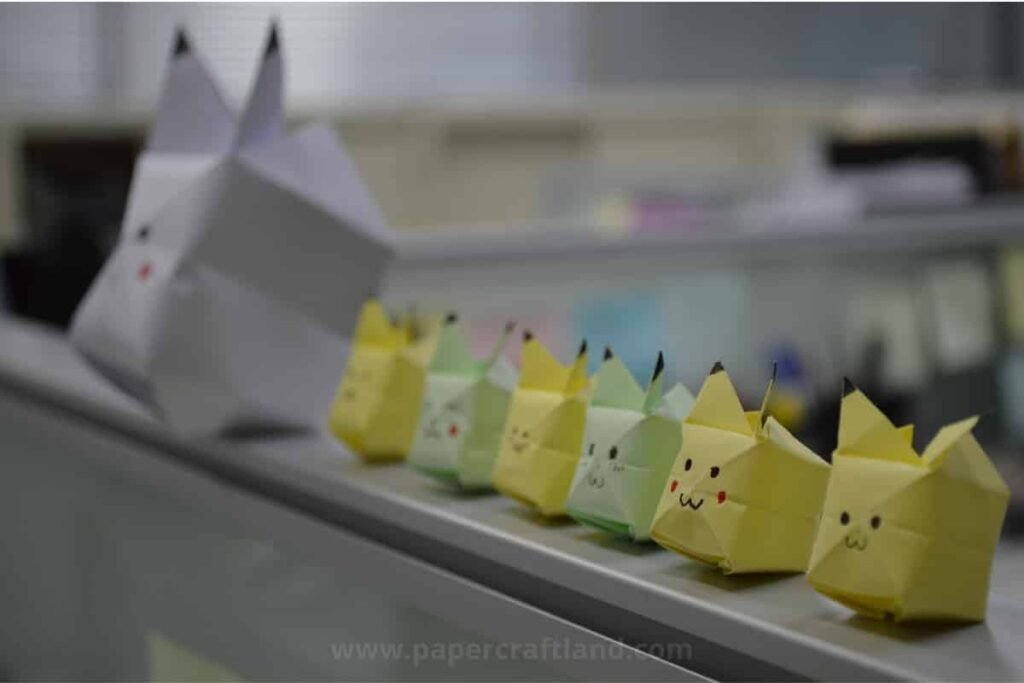Introduction
The origami balloon, also known as a waterbomb, is a delightful example of the ancient Japanese art of paper folding. Starting as a flat square, it transforms into a three-dimensional, air-filled shape with just a few folds and a gentle puff of air.
Simple yet enchanting, the origami balloon is a popular model among both beginners and seasoned paper folders. Its ease of creation, combined with its playful design, makes it a favorite in the world of origami.
Beyond its aesthetic appeal, the origami balloon holds cultural significance in Japan, symbolizing lightness and simplicity. This charming paper craft continues to captivate people of all ages around the globe.
- Introduction
- The History of Origami
- Understanding the Origami Balloon
- Materials Needed for Creating an Origami Balloon
- Advanced Techniques for Origami Balloon Making
- Creative Uses of Origami Balloons
- Cultural Significance of Origami Balloons in Japan
- Origami Balloon in Modern Art and Craft
- The Therapeutic Benefits of Origami
- Origami Balloon for Kids
- Origami Balloon Challenges and Competitions
- Common Mistakes and How to Avoid Them
- Sustainability and Origami
- Conclusion
- FAQs
The History of Origami
Origami originated in Japan, with roots tracing back over a thousand years. It began as a ceremonial practice in religious rituals, where paper was folded to accompany sacred offerings. As paper became more accessible, origami evolved into a popular craft among all social classes.
The origami balloon, also known as the waterbomb or “kami fusen” in Japanese, emerged as one of the traditional models. Over time, origami expanded beyond Japan, influencing cultures worldwide and evolving into a sophisticated art form that bridges tradition and innovation.
Understanding the Origami Balloon

The origami balloon is a simple yet elegant paper model characterized by its hollow, air-filled structure. Unlike most origami models, which maintain a flat appearance, the balloon becomes three-dimensional when inflated.
This unique feature makes it a popular choice for beginners and experienced origami enthusiasts alike. In Japanese culture, the origami balloon symbolizes lightness and simplicity, often used as a playful decoration or a child’s toy.
Its basic form invites endless possibilities for variation and personalization, making it a versatile element in the world of paper folding.
Materials Needed for Creating an Origami Balloon
Creating an origami balloon requires minimal supplies, making it an accessible craft for anyone interested in origami. Here’s what you’ll need:
- Paper: The most crucial material is, of course, paper. Origami paper, often called “kami,” is ideal due to its square shape and perfect thickness. Standard origami paper is typically 15 cm x 15 cm, but you can use any square piece of paper.
- Optional Supplies: While not necessary, you might consider decorative elements like markers or stickers to personalize your balloon.
- Paper Quality: The quality of the paper can significantly affect the outcome of your balloon. Thinner paper is easier to fold and inflate, while thicker paper may be more challenging but can hold its shape better.
Step-by-Step Guide to Making an Origami Balloon
Let’s walk through the process of making an origami balloon step by step:
- Start with a Square Sheet of Paper: Place your paper on a flat surface, with the colored side facing down.
- Fold Diagonally in Both Directions: First, fold the paper in half diagonally, then unfold it. Repeat for the opposite diagonal. This will create two creases that intersect at the center.
- Fold Horizontally and Vertically: Fold the paper in half horizontally and vertically, then unfold each time. You should now have a grid of creases forming a star pattern.
- Collapse into a Triangle: Bring the top and bottom corners together along the diagonal creases, forming a flat triangle with two layers.
- Fold the Corners to the Top: Take each corner of the triangle’s base and fold them up to meet the top point, creating a diamond shape.
- Tuck in the Side Flaps: Fold the left and right edges of the diamond toward the center. Tuck the tips into the pockets formed by the previous folds.
- Inflate the Balloon: Find the small hole at the bottom of your model. Gently blow into it, and your balloon will inflate.
These steps may seem intricate at first, but with practice, you’ll be able to create an origami balloon with ease.
Advanced Techniques for Origami Balloon Making

Once you’ve mastered the basic origami balloon, you can explore more advanced techniques to enhance your creations. For instance, you can experiment with:
- Color Patterns: Use paper with different colors on each side or create multi-colored balloons by using different papers.
- Size Variations: Try making tiny balloons with small squares or larger balloons with big sheets of paper. Scaling up requires precise folding to maintain the balloon’s structure.
- Complex Designs: Add more folds or combine balloons into intricate structures, like origami clusters or decorative garlands.
Creative Uses of Origami Balloons
Origami balloons are not just beautiful; they’re also incredibly versatile. Here are a few imaginative ways to use them:
- Decorative Purposes: String several balloons together to create a garland, or scatter them around a table as colorful, lightweight decorations.
- Practical Uses: Use them as eco-friendly gift wraps by inserting small treats or gifts inside. They also make unique party favors that guests can take home.
- Educational Uses: Origami balloons can be used in classrooms to teach geometry, spatial awareness, and following instructions.
Cultural Significance of Origami Balloons in Japan
In Japan, the origami balloon has a deep cultural resonance. Traditionally, they were used in various ceremonies and festivals, often symbolizing joy and celebration.
During Tanabata, the star festival, origami decorations, including balloons, are hung on bamboo branches as offerings to the stars. The lightness and simplicity of the balloon reflect the transient beauty and delicacy of life, themes central to Japanese aesthetics.
Origami Balloon in Modern Art and Craft
Today, the influence of origami balloons extends beyond traditional craft. They have found a place in modern art, with artists creating large-scale installations that play with light and shadow.
Fashion designers have also incorporated origami-inspired folds into their designs, creating garments that mimic the geometric precision of paper models. Public art installations often use the form of origami balloons to symbolize unity and creativity, making them a powerful tool for artistic expression.
The Therapeutic Benefits of Origami

Engaging in origami, including making balloons, offers several therapeutic benefits. The repetitive, precise movements required for folding can induce a state of mindfulness, helping to reduce stress and anxiety.
The sense of accomplishment that comes from completing a model, especially one that inflates into a three-dimensional form, can boost self-esteem and provide a sense of calm. Origami is also a social activity, bringing people together to share in the joy of creation, making it a great group activity for building connections.
Origami Balloon for Kids
Origami balloons are an excellent introduction to paper folding for children. The simple steps are easy for little hands to manage, and the final product—an inflatable balloon—adds a fun element of surprise.
This craft can teach kids important skills like patience, concentration, and fine motor control. It also encourages creativity, as children can decorate their balloons with drawings or stickers.
Origami Balloon Challenges and Competitions
For those who love a challenge, origami balloons can be a gateway to competitive origami. These events test participants’ speed, accuracy, and creativity in folding complex models.
Competitions often include timed challenges where participants must create a perfect balloon in record time. To improve your origami balloon skills, practice is key—focus on precision and try experimenting with different paper types and sizes.
Common Mistakes and How to Avoid Them
Even the simplest origami models can present challenges. Here are some common mistakes when making an origami balloon and how to avoid them:
- Misaligned Folds: Ensure that each fold is precise and sharp. Misaligned folds can result in a misshapen balloon.
- Tearing the Paper: Be gentle when blowing into the balloon to avoid tearing. Using paper that’s too thin or not durable can increase the risk of rips.
- Lack of Inflation: If the balloon doesn’t fully inflate, check to see if all the folds are correctly tucked in and that there are no gaps for air to escape.
Sustainability and Origami
In an era where sustainability is increasingly important, origami offers a way to engage with crafts that are eco-friendly.
You can use recycled paper or paper from old magazines and newspapers to create your balloons, reducing waste and giving materials a new life. This not only minimizes environmental impact but also encourages a more mindful approach to crafting.
Conclusion
The origami balloon, with its delicate folds and airy structure, is a testament to the beauty and simplicity of origami.
Whether used as a playful decoration, a teaching tool, or a therapeutic exercise, it embodies the elegance of Japanese culture and the joy of creation. As you practice and perfect your origami balloon skills, you’ll discover the endless possibilities this simple model offers, both in its form and its significance.
FAQs
- What is the time required to make an origami balloon?
Typically, it takes about 5-10 minutes to make an origami balloon, depending on your experience level.
- Can I use any type of paper for making an origami balloon?
While any square piece of paper can work, origami paper is recommended for the best results due to its ideal thickness and size.
- What is the significance of the origami balloon in Japanese culture?
The origami balloon symbolizes lightness and simplicity and is often used in traditional Japanese ceremonies and festivals.
- Are there any digital resources or apps for learning origami?
Yes, there are numerous apps and online tutorials that provide step-by-step instructions for making various origami models, including the balloon.
- Can origami balloons be used in outdoor decorations?
Origami balloons can be used outdoors, but they are best suited for dry conditions as they can be damaged by moisture or wind.
- Can origami balloons hold water?
Yes, origami balloons can hold water temporarily, but they are not waterproof and will eventually leak.
- Is the origami balloon suitable for beginners?
The origami balloon is one of the easiest models and is perfect for beginners.





I am really impressed together with your writing talents and also with thee format
in your blog. Is that this a paid subject or did you mmodify it yourself?
Either wayy keep up the excellent high quality writing, itt is rare to look
a nice weblog lie this one today..
Thanks for your comment